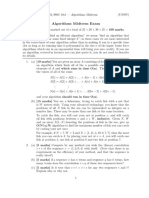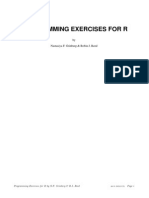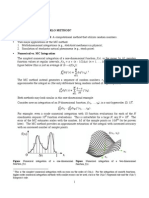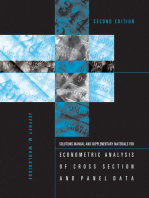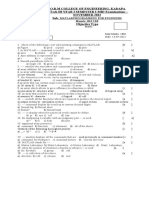Multilateration Assignment
Multilateration Assignment
Uploaded by
Saniya MaheshwariCopyright:
Available Formats
Multilateration Assignment
Multilateration Assignment
Uploaded by
Saniya MaheshwariOriginal Description:
Copyright
Available Formats
Share this document
Did you find this document useful?
Is this content inappropriate?
Copyright:
Available Formats
Multilateration Assignment
Multilateration Assignment
Uploaded by
Saniya MaheshwariCopyright:
Available Formats
Workshop on Location Tracking for Internet of Things
IIT Madras
Multilateration
Self-Assessment Assignment
Consider a 2D-grid of MxN cells where we want to
locate an IoT device (marked as N) using
multilateration. The lower-left corner cell can be
treated as the origin (0,0) while the location of the top-
right cell is (M, N). Assume that all anchors (A , A and 1 2,
A ) are kept at known locations.
3
Task 1: Dataset Generation. Simulate grid of size
100x100. Consider 3 anchors.
a. Randomly generate 100 unique anchor location
sets and for each randomly generated anchor location
set, generate 50 random unique node locations
(programming hint: use a Set ADT while generating
the data). All such location points should be within the
simulated grid’s bounding box. Write this data to a file,
<true_locations.csv>
[(x ,y ),(x , y ),(x , y )] , (NX , NY ), .. (NX , NY )
1 1 2 2 3 3
1
1 1 50 50
[(x ,y ),(x , y ),(x , y )] , (NX , NY ), .. (NX , NY )
1 1 2 2 3 3
2
1 1 50 50
… … … … … …
[(x ,y ),(x , y ),(x , y )] , (NX , NY ), .. (NX , NY )
1 1 2 2 3 3
100
1 1 50 50
b. Generate the range values for each node location to the respective anchors and write
them to a file <pure_ranges.csv>
[(x ,y ),(x , y ),(x , y )] , (R ,R ,R ) , .. (R ,R ,R )
1 1 2 2 3 3
1
1 2 3
1
1 2 3
50
… … … … … …
[(x ,y ),(x , y ),(x , y )] , (R ,R ,R ) , .. (R ,R ,R )
1 1 2 2 3 3
100
1 2 3
1
1 2 3
50
c. Now generate noisy range values for each node location by adding Gaussian noise to
each pure range value as in <pure_ranges.csv>. R = R + N(μ,σ). Generate three datasets,
noisy pure
for μ = 0.5, 1 and 2. Assume σ = 0.1 for all cases. Write these data into three files
<noisy_ranges_05.csv>, <noisy_ranges_1.csv> and <noisy_ranges_2.csv>
Task 2: Range Equations. Generate two random numbers, A in [1, 100] and B in [1, 50].
Choose the A line and the B node location from the files in (a), (b), and (c).
th th
a. Form the cost function (use root mean square error) using
the three range equations for that particular node and anchor
locations. Evaluate the “cost value” for all the 100x100 cells
for <pure_ranges.csv>, <noisy_ranges_05.csv>,
<noisy_ranges_1.csv> and <noisy_ranges_2.csv>. While
evaluating your cost function put (X = i and Y = j) where i and
j are integers in [0,99]. Visualize the normalized cost values
(scale: 0 to 1) in the form of a heatmap. Plot the 4 heatmaps.
Don’t interpolate your heatmaps.
Instructor: Ayon Chakraborty, SENSE Lab, IIT Madras
b. Summarize your observations. Did you realize the fact that we are trying to use a brute-
force approach to scan all possible cells for the solution? Is the cell with the global minima
near (or, how far from) the actual node location? (cost value = 0 for non-noisy case) Are
there local minima present in the noisy cases?
Task 3: Trilateration. Now use an optimizer to solve for the node location for all 100x50
node locations (pure + 3 noisy versions). If you are using python, use lmfit
(https://lmfit.github.io/lmfit-py/). Round off the output of the solver to the nearest integer
value, say if the solver outputs (50.69, 45.23) - round it off to (51, 45) for the estimated
location cell. Also make sure the solver knows the limits of the solution (i.e., the bounding
box). Write the solvers output into 4 files, <pure_locs.csv>, <noisy_locs_05.csv>,
<noisy_locs_1.csv> and <noisy_locs_2.csv>. Compare the solved locations with the entries
in <true_locations.csv> and compute the localization errors (Euclidean distance between
true and estimated location).
a. Plot 4 CDFs (each for the 5000 error values) on the same graph, to compare the 4
cases.
b. For the 4 cases state the: (i) median error, (ii) 75th percentile error, and (iii) 95th
percentile error.
Task 4: Impact of anchor points.
a. Compute the median localization error for the 50 locations per anchor location. You
will have 100 such median values for 100 anchor locations each for the 4 cases. Draw 4
error histograms. Use the same x-axis range for all the 4 histograms, so that they can be
compared easily.
b. Do some anchor locations tend to produce more erroneous results than others?
Recall, that the specific anchor location geometry influences the GDoP - collinear anchor
points tend to produce higher errors. Comment based on the above histograms - for
instance, do you observe error clusters that are correlated to similar relative geometry of the
anchor points?
c. Can you come up a simple metric based solely on the anchors’ coordinates realized
by the function signature, F((x ,y ),(x , y ),(x , y )) that is highly correlated to the
1 1 2 2 3 3
magnitude of the localization errors? This is a slightly open-ended question and any
reasonable answer is acceptable. Can this “F” be learned from data?
Instructor: Ayon Chakraborty, SENSE Lab, IIT Madras
You might also like
- Algorithms Midterm ExamDocument2 pagesAlgorithms Midterm ExamjzdoogNo ratings yet
- 半导体物理与器件第四版课后习题答案3Document14 pages半导体物理与器件第四版课后习题答案3DavidNo ratings yet
- Annual Accomplishment Report in Mathematics S.Y 2016-2017Document3 pagesAnnual Accomplishment Report in Mathematics S.Y 2016-2017NATHANIEL GALOPO100% (6)
- Chapter 8 - Solutions PDFDocument39 pagesChapter 8 - Solutions PDFMohsin50% (4)
- Patter Recognition (Spring 2013) Midterm ExamDocument4 pagesPatter Recognition (Spring 2013) Midterm ExamranaNo ratings yet
- Maths Practicesheet-03 (Code-A) Ques.Document5 pagesMaths Practicesheet-03 (Code-A) Ques.ksanthosh29112006No ratings yet
- Matlab Lab 2: Visualization and ProgrammingDocument28 pagesMatlab Lab 2: Visualization and ProgrammingWajih KhanNo ratings yet
- ECE120L - Activity 4Document9 pagesECE120L - Activity 4Duper FuberNo ratings yet
- ch9 d1813647-108Document4 pagesch9 d1813647-108s95013019No ratings yet
- 5156165Document4 pages5156165s95013019No ratings yet
- WORKSHEET - 1 (On Convex Set) .Document10 pagesWORKSHEET - 1 (On Convex Set) .Gudeta nNo ratings yet
- $$$tutorDocument2 pages$$$tutorAldrynOscarAparcanaOrellanaNo ratings yet
- Octave PlottingDocument11 pagesOctave Plotting88915334No ratings yet
- 4311668368487Document9 pages4311668368487Clement KipyegonNo ratings yet
- Experiment 2 ExpressionsDocument4 pagesExperiment 2 Expressionskurddoski28No ratings yet
- 6.867 Machine Learning: Mid-Term Exam October 13, 2004Document11 pages6.867 Machine Learning: Mid-Term Exam October 13, 2004Dickson SamwelNo ratings yet
- Kami Export - Seohyeon Lee - Sample Test 3Document5 pagesKami Export - Seohyeon Lee - Sample Test 3jaynalee326No ratings yet
- 02 Prog I ExaminationsDocument6 pages02 Prog I ExaminationsAmir Mohamed Nabil Saleh ElghameryNo ratings yet
- Matlab - Introduction SlidesDocument52 pagesMatlab - Introduction SlidesFernanda ModkowskiNo ratings yet
- EIE520 Neural Computation: The Hong Kong Polytechnic UniversityDocument14 pagesEIE520 Neural Computation: The Hong Kong Polytechnic Universitytest hackNo ratings yet
- Basic Vector Space Methods in Signal and Systems Theory 5.2Document42 pagesBasic Vector Space Methods in Signal and Systems Theory 5.2Parekh Prashil BhaveshbhaiNo ratings yet
- Tutorial 1Document3 pagesTutorial 1anon_545085293No ratings yet
- 21mat105 Mis-1 Lab Practicesheet-6 (Spanset Rs Cs NS)Document3 pages21mat105 Mis-1 Lab Practicesheet-6 (Spanset Rs Cs NS)Dinesh SomisettyNo ratings yet
- Lecture - 3 - Image - Processing - Toolbox - IPT - MatlabDocument4 pagesLecture - 3 - Image - Processing - Toolbox - IPT - Matlabom55500rNo ratings yet
- Final Examination - Attempt ReviewDocument26 pagesFinal Examination - Attempt ReviewcvkcuongNo ratings yet
- Vector Fields and Solutions To Ordinary Differential Equations UsingDocument10 pagesVector Fields and Solutions To Ordinary Differential Equations UsingphysicsnewblolNo ratings yet
- The Matlab LanguageDocument30 pagesThe Matlab LanguageShubham GargNo ratings yet
- 6390 Fall 2022 MidtermDocument20 pages6390 Fall 2022 MidtermDaphne LIUNo ratings yet
- Test Zbi 2013Document144 pagesTest Zbi 2013lformula6429No ratings yet
- ScientificComputing HW2Document2 pagesScientificComputing HW2arashnasr79No ratings yet
- 23 test 4 QPDocument10 pages23 test 4 QPumamaheswari.goallaNo ratings yet
- Sample Exam PDFDocument4 pagesSample Exam PDFAnkit RadiaNo ratings yet
- Tema 8Document18 pagesTema 8guillermo araus pérezNo ratings yet
- Winsem2020-21 Eee1007 Eth Vl2020210500383 Model Question Paper Eee1007 QPDocument4 pagesWinsem2020-21 Eee1007 Eth Vl2020210500383 Model Question Paper Eee1007 QPAPURVA PATEL 19BEI0020No ratings yet
- Homework 6 (MIDTERM #2) : Regression and SparsityDocument1 pageHomework 6 (MIDTERM #2) : Regression and SparsityEmin OzkanNo ratings yet
- Rexercises 1 R BasicDocument35 pagesRexercises 1 R BasicJohn StephenNo ratings yet
- R ExercisesDocument35 pagesR ExercisesAti SundarNo ratings yet
- 033 SurbhiGole A1Document18 pages033 SurbhiGole A1Surbhi GoleNo ratings yet
- Quiz1 PyDocument12 pagesQuiz1 PyNohan JoemonNo ratings yet
- Assignment 2: Accepted AnswersDocument10 pagesAssignment 2: Accepted AnswersxlntyogeshNo ratings yet
- Lecture 2, Bahman MoraffahDocument46 pagesLecture 2, Bahman MoraffahElhamNo ratings yet
- Programming Exercises For R: by Nastasiya F. Grinberg & Robin J. ReedDocument35 pagesProgramming Exercises For R: by Nastasiya F. Grinberg & Robin J. ReedElena50% (2)
- CS725 2020 MidsemDocument3 pagesCS725 2020 Midsemtatha.researchNo ratings yet
- MAT1841 AppclassquestionsDocument27 pagesMAT1841 Appclassquestions邱顯鑫No ratings yet
- Assignment 4Document3 pagesAssignment 4VijayNo ratings yet
- Solutions+to+Review+24-25+ (Chapter+3)Document4 pagesSolutions+to+Review+24-25+ (Chapter+3)meryemorazoNo ratings yet
- Monte Carlo BasicsDocument23 pagesMonte Carlo BasicsIon IvanNo ratings yet
- Les Bases Du Langage RDocument30 pagesLes Bases Du Langage RCarn1935No ratings yet
- Functions in MATLAB: X 2.75 y X 2 + 5 X + 7 y 2.8313e+001Document21 pagesFunctions in MATLAB: X 2.75 y X 2 + 5 X + 7 y 2.8313e+001Rafflesia KhanNo ratings yet
- Plotting of Curves and SurfacesDocument9 pagesPlotting of Curves and SurfacesakshathashreeprakashNo ratings yet
- 02 HomeworkDocument2 pages02 Homeworknikaabesadze0No ratings yet
- Indian Institute of Technology Bombay Linear Algebra MA106 Tutorial 5,6 SolutionsDocument15 pagesIndian Institute of Technology Bombay Linear Algebra MA106 Tutorial 5,6 Solutionsjeferson.ordonioNo ratings yet
- Ugc Net Math PDFDocument16 pagesUgc Net Math PDFRam100% (1)
- Math II-BA124 1st 2010-2011 - e ExamDocument2 pagesMath II-BA124 1st 2010-2011 - e ExamALI ELOUNYNo ratings yet
- Universidad Nacional Del Altiplano: Capitulo 0Document35 pagesUniversidad Nacional Del Altiplano: Capitulo 0Alexander ChinoNo ratings yet
- Problem Set 1Document3 pagesProblem Set 1shrutiNo ratings yet
- Student Solutions Manual to Accompany Economic Dynamics in Discrete Time, second editionFrom EverandStudent Solutions Manual to Accompany Economic Dynamics in Discrete Time, second editionRating: 4.5 out of 5 stars4.5/5 (2)
- Log-Linear Models, Extensions, and ApplicationsFrom EverandLog-Linear Models, Extensions, and ApplicationsAleksandr AravkinNo ratings yet
- Student's Solutions Manual and Supplementary Materials for Econometric Analysis of Cross Section and Panel Data, second editionFrom EverandStudent's Solutions Manual and Supplementary Materials for Econometric Analysis of Cross Section and Panel Data, second editionNo ratings yet
- De Moiver's Theorem (Trigonometry) Mathematics Question BankFrom EverandDe Moiver's Theorem (Trigonometry) Mathematics Question BankNo ratings yet
- Inverse Trigonometric Functions (Trigonometry) Mathematics Question BankFrom EverandInverse Trigonometric Functions (Trigonometry) Mathematics Question BankNo ratings yet
- Formal Languages and Automata Theory June July 2022Document8 pagesFormal Languages and Automata Theory June July 2022Hello HelloNo ratings yet
- (Trends in Linguistics, Studies and Monographs 210) Johannes Helmbrecht, Stavros Skopeteas, Yong-Min Shin, Elisabeth Verhoeven-Form and Function in Language Research_ Papers in Honour of Christian Leh.pdfDocument363 pages(Trends in Linguistics, Studies and Monographs 210) Johannes Helmbrecht, Stavros Skopeteas, Yong-Min Shin, Elisabeth Verhoeven-Form and Function in Language Research_ Papers in Honour of Christian Leh.pdfSilvia LuraghiNo ratings yet
- Assignment 5Document64 pagesAssignment 5Sheetal AnandNo ratings yet
- NTOUMSV工數教科書Solution ManualDocument4 pagesNTOUMSV工數教科書Solution ManualHomeo StasisNo ratings yet
- Course Form - SECOND SEMESTER, 2023 - 2024Document1 pageCourse Form - SECOND SEMESTER, 2023 - 2024absalomi088No ratings yet
- Paper - INDOROCK 2016 - Saptshrungi Gad PDFDocument16 pagesPaper - INDOROCK 2016 - Saptshrungi Gad PDFRoshanRSVNo ratings yet
- 2CE01Document2 pages2CE01darshantalpda07080901No ratings yet
- Unit 9 _Resistors in ParallelDocument12 pagesUnit 9 _Resistors in ParallelRashaan NosengaNo ratings yet
- The Normal Distribution: Central Limit Theorem. This Is A Theorem Due To Pierre Simon Laplace (1749Document40 pagesThe Normal Distribution: Central Limit Theorem. This Is A Theorem Due To Pierre Simon Laplace (1749Notaul NerradNo ratings yet
- Module5 DMWDocument13 pagesModule5 DMWSreenath SreeNo ratings yet
- Mineral Processing Ppt-1. Smelter Schedule Flow Sheets, Size, Shape, Size Distribution, Sieving and LiberationDocument58 pagesMineral Processing Ppt-1. Smelter Schedule Flow Sheets, Size, Shape, Size Distribution, Sieving and LiberationParth DesaiNo ratings yet
- CTJV801 A Practical Public Key Encryption Scheme Based On Learning Parity With NoiseDocument11 pagesCTJV801 A Practical Public Key Encryption Scheme Based On Learning Parity With NoisebhasutkarmaheshNo ratings yet
- p.7 Examination 2023 MathematicsDocument59 pagesp.7 Examination 2023 MathematicsJoshua OundoNo ratings yet
- Metrika 2Document6 pagesMetrika 2ბექა ბაიაშვილიNo ratings yet
- Bond MathematicsDocument68 pagesBond MathematicsDeepali JhunjhunwalaNo ratings yet
- Matlab Mid-IDocument2 pagesMatlab Mid-IShiak AmeenullaNo ratings yet
- ADA Assignment - Final - 2024Document5 pagesADA Assignment - Final - 2024bida22-016No ratings yet
- Multiphase Systems PDFDocument11 pagesMultiphase Systems PDFDicky HartantoNo ratings yet
- Analysis and Trans-Synthesis of Acoustic Bowed-String InstrumentDocument5 pagesAnalysis and Trans-Synthesis of Acoustic Bowed-String InstrumentconollycelloNo ratings yet
- 6 GTC ProceedingsDocument262 pages6 GTC ProceedingsCodrutaNo ratings yet
- Functions in C++Document23 pagesFunctions in C++Abhishek ModiNo ratings yet
- Docs Slides Lecture15Document37 pagesDocs Slides Lecture15PravinkumarGhodakeNo ratings yet
- Difference Between RMS and Average CurrentDocument6 pagesDifference Between RMS and Average CurrentAjay UllalNo ratings yet
- Baja VehicleDocument6 pagesBaja VehicleSai Krishna SKNo ratings yet
- The Works of Edgar Allan Poe 081 The Purloined Letter PDFDocument14 pagesThe Works of Edgar Allan Poe 081 The Purloined Letter PDFSumon HazraNo ratings yet
- Preparation Paper 1 (X Maths)Document2 pagesPreparation Paper 1 (X Maths)Quirat RanaNo ratings yet
